This statement was the wry response to a comment I made in Hougen’s SportLodge in Whitehorse about northern hunters. We had dropped in to buy campground permits and started a conversation about the back wall lined with guns and ammo. And no, this is not an anti-gun tirade – this is the land of hunting and trapping and fishing and these are the necessary tools.
I unnecessarily informed the sales staff that, “I’m from down south“, after expressing surprise about a small pink gun for children called “My First Rifle.” I told them I thought all hunters were burly bearded men and that is when 22-year-old Ashley set me straight.
This is what a Yukon hunter looks like.

This Yukon native first picked up a 22 at the age of three or four and has been hunting with her father and grandfather ever since. Her family loves the outdoors, loves hunting and fishing, have a trapline and a cabin four hours outside of Whitehorse where they go on hunting trips a few times a year. Ashley has owned many rifles and has shot “every kind of large animal in the Yukon“. She gave me the following list, with the type of rifle she used for the hunt: Black bear (30-06), bison (338), caribou (7mm-08), sheep (7 mm-08) and moose ( 30-06).
Ashley helped to blow up a stereotype – competency with guns and a comfort level being out in the bush does not just belong to the burly bearded guys. One of the things we are discovering about the Yukon is that the people here cannot be pigeonholed.
We bought shoes from a young man from Barcelona who left his country a few years ago to seek a better future and has been happily living in Whitehorse for the past two years. We bought coffee from a Mississauga man who came for a visit and fell in love with the place.
There are the characters – the ones who won’t be told.

The legendary Yukoners, such as the late Alex Van Bibber
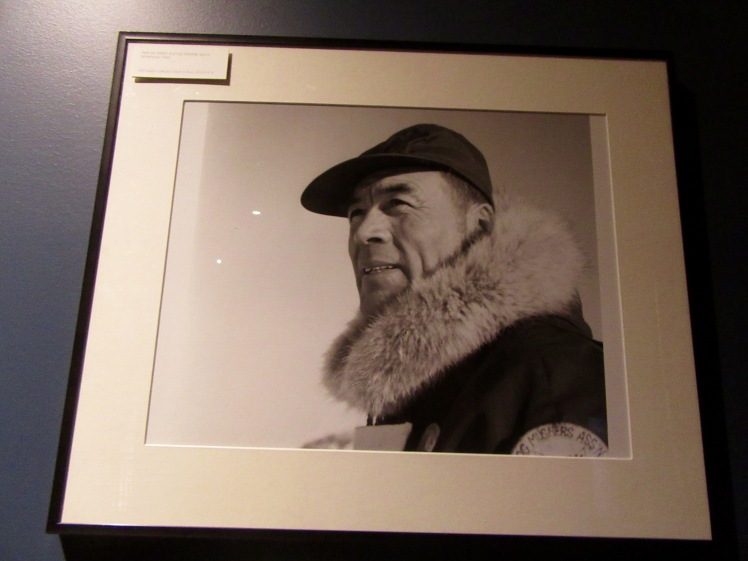
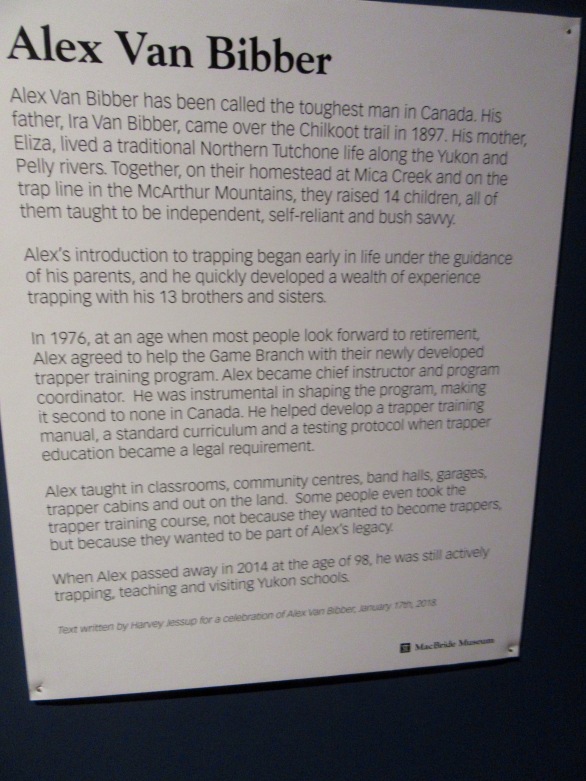
We met a young German man at our campground a few nights ago who was a protege of Alex Van Bibber. His parents were visiting from Germany for the summer and his dad told us the story. “Our son knew from when he was a little boy he wanted to live in the north of Canada. He is currently a guide-outfitter, but when he first moved to the Yukon he had a lot to learn. He was canoeing in very fast water, tipped over and would have drowned, except Alex Van Bibber happened to notice him and saved his life. He took him under his wing after that and was his friend until his death five years ago.”
This incredible story is not uncommon up north. It can be dangerous here, with extreme weather, extreme temperatures, large animals, avalanches, landslides, wildfires, etc. You have to learn to fend for yourself and keep an eye out for others.
We’ve been in Whitehorse for a few days and we are liking it a lot more than we expected. I had imagined a rather featureless capital city, with squat buildings and big box stores. There are those, of course, but there is also a log “skyscraper”, which is a clever stack of three log cabins; a mini northern apartment building.
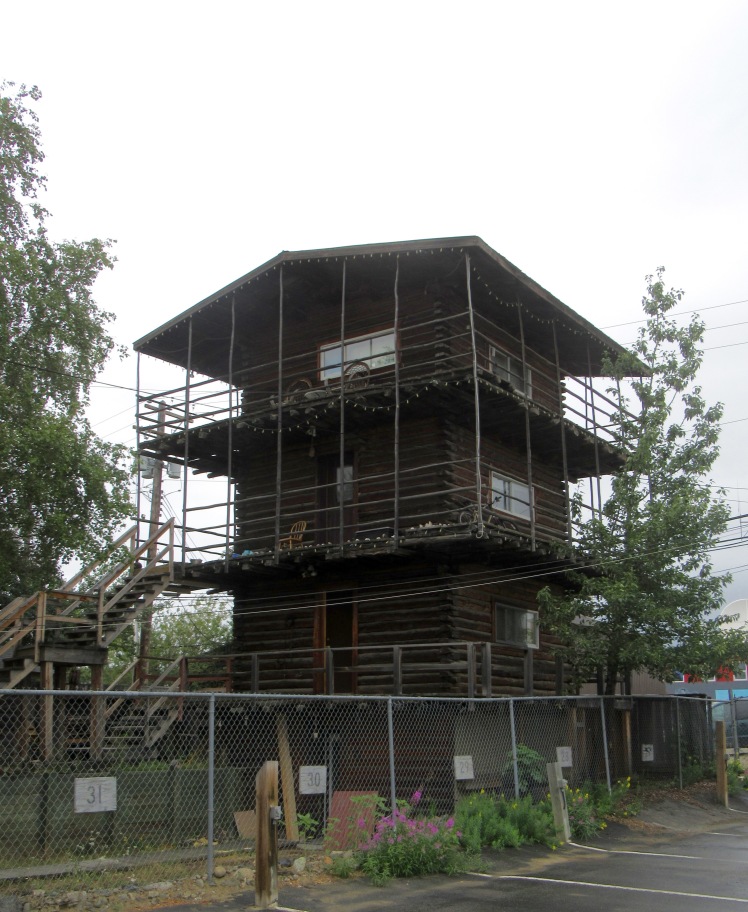
Other old log buildings:
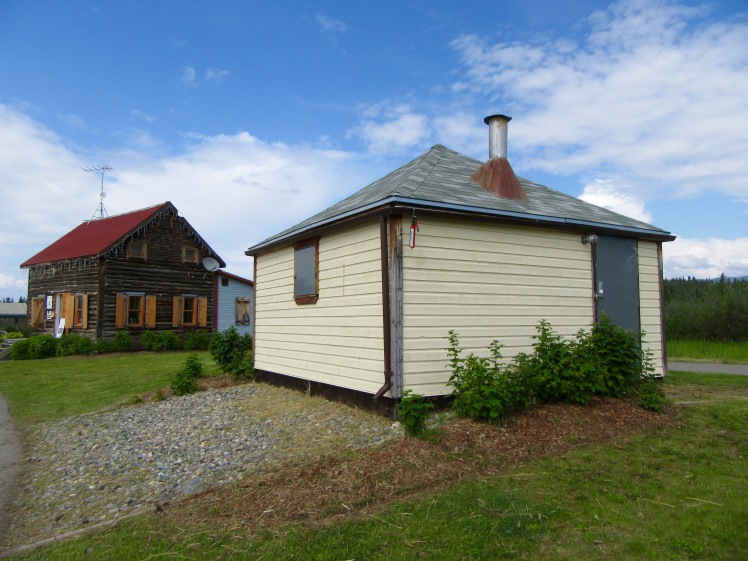

The White Pass & Yukon Route station is one of the stops for the Whitehorse-Carcross-Skagway narrow gauge railroad. The line was built in 1898 during the Klondike Gold Rush and now operates as a tourist attraction.

This plaque on the station tells a little of the story of how the building of the Alcan Highway transformed Whitehorse.
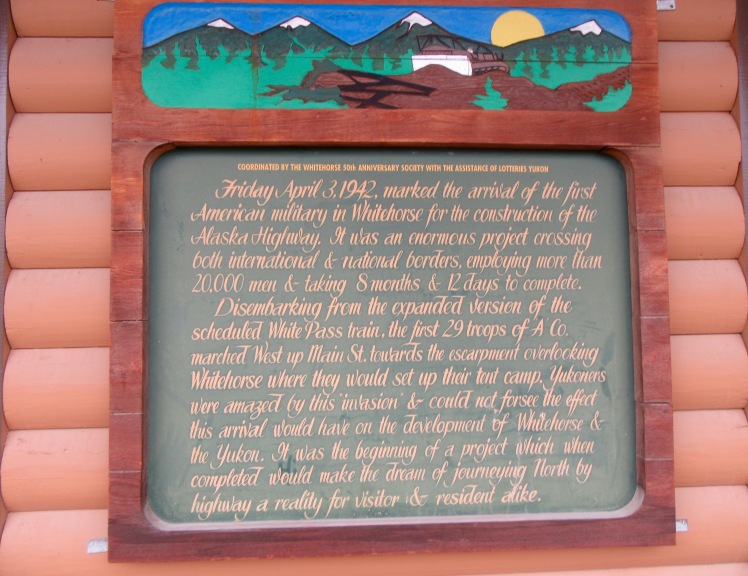
The downtown has a lot of thriving businesses that have been around for years.

Love the old signs and neon. Murdoch’s is a venerable old store in Whitehorse.
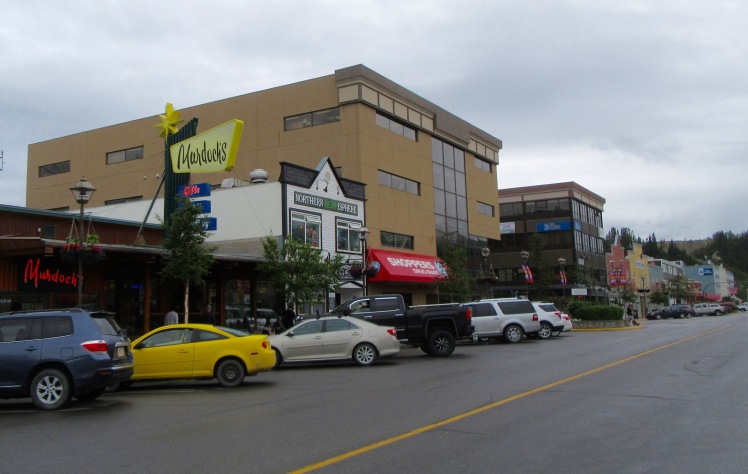
So is the Edgewater Hotel. There is lots of competition since its heyday, but the neon has not quite given up.
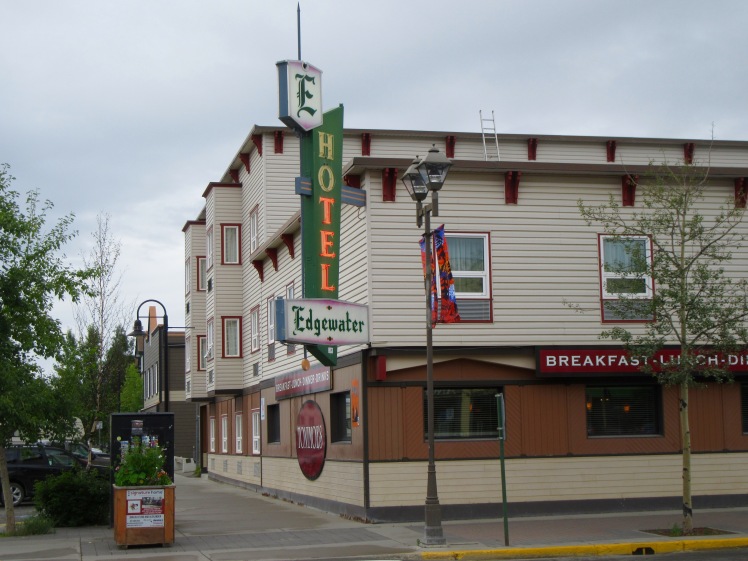
We ate very well at the Klondike Rib & Salmon, a restaurant that is housed in one of the two oldest operating buildings in Whitehorse. It was a bakery in 1900 and then became a mail and freight business, a carpentry shop and now a landmark restaurant with non-stop lineups. We had very fresh halibut & chips and a couple of beers from Yukon Brewing.
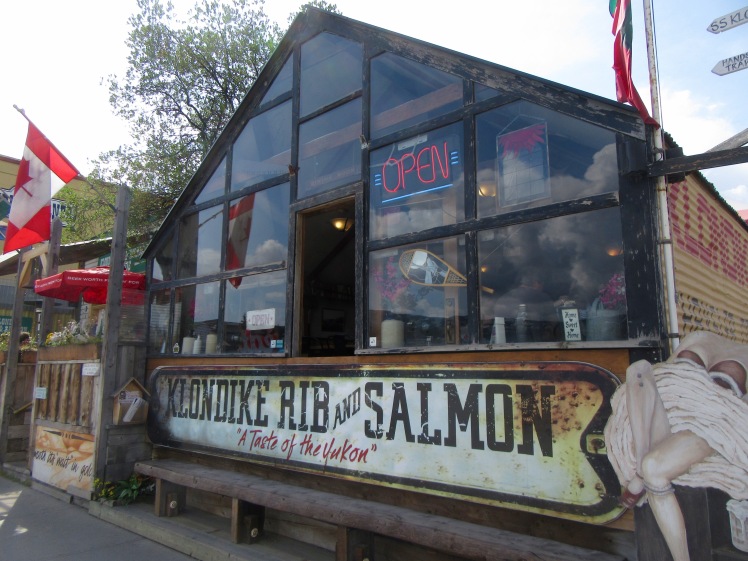
Whitehorse is a young town and so new businesses have popped up. The creativity is inspiring.

Lumel Studios offers glass-blowing workshops and demos, as well as a large gallery. We admired this Chihuly- inspired piece in the garden.
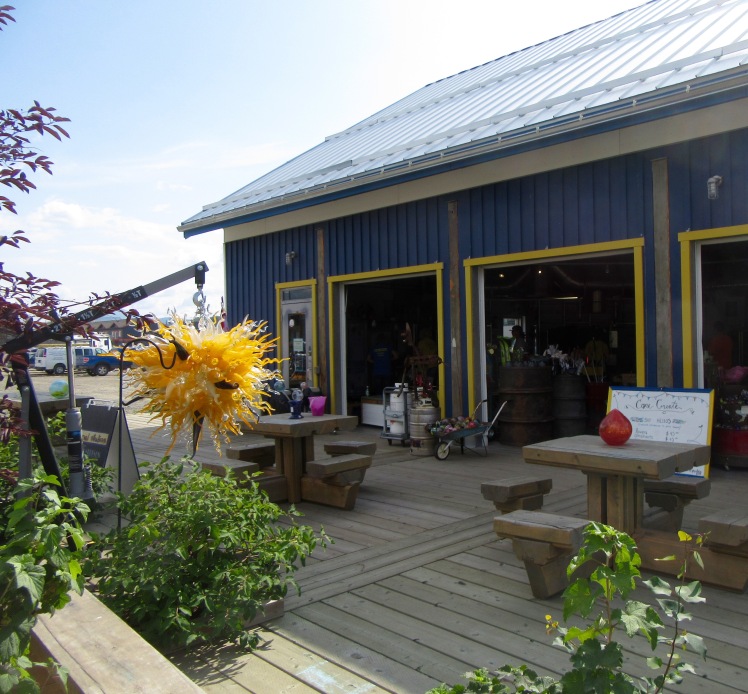
Even Starbucks has been “Yukon-ed.”

Driving up the Alaska Highway is a motorcycle magnet. This group travelled all the way from Mexico.

Murals can be found all over town. The building of the Alaska Highway and the Klondike Gold Rush over the Chilkoot Trail are two main motifs.

CBC Radio has a mural of its own – take a close look for a certain Peter Gzowski. Can this be the same Mr. Canada we all knew and loved?

Downtown Whitehorse is set back from the Yukon River, with a beautifully developed waterfront that runs for several kilometres.

The S.S. Klondike was the flagship sternwheeler of the BYN fleet, that used to run the Yukon River between Whitehorse and Dawson City. She was built in 1929, sank in 1936 and re-built the spring of 1937, using the original structure and machinery salvaged from the wreck. She continued to carry passengers and cargo until 1955 – the last Yukon River sternwheeler in service. She has been restored to her 1937-40 appearance and is designated a National Historic Site.
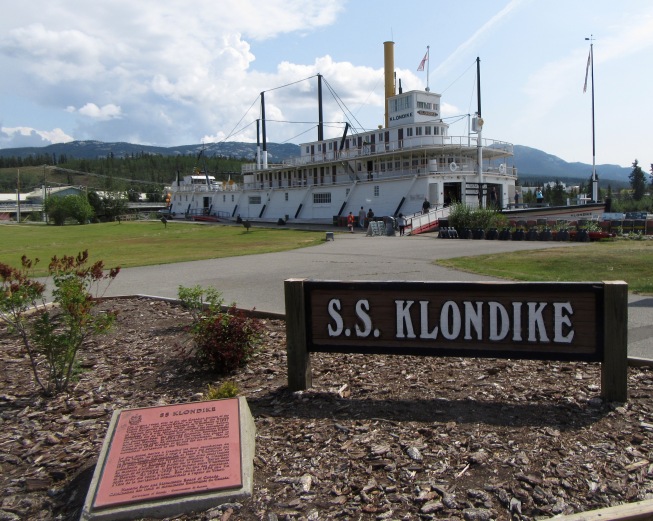
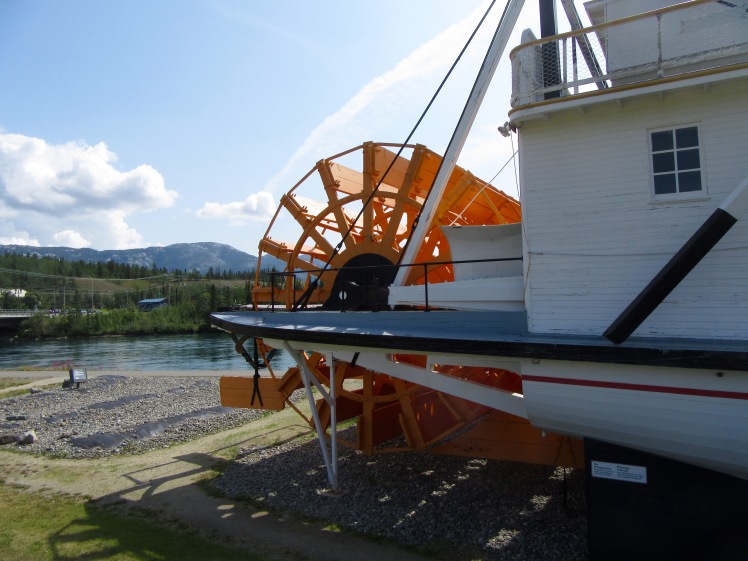
We watched an old NFB film about the operations of the sternwheelers; the jerky-jerky motions of excited guests waving to those on shore. It was interesting to walk the decks and imagine how it must have been to be a passenger, all gowned and hatted in 30 degree heat.
It was even more interesting to go below and see where the cargo was stored, as well as the second-class passengers.
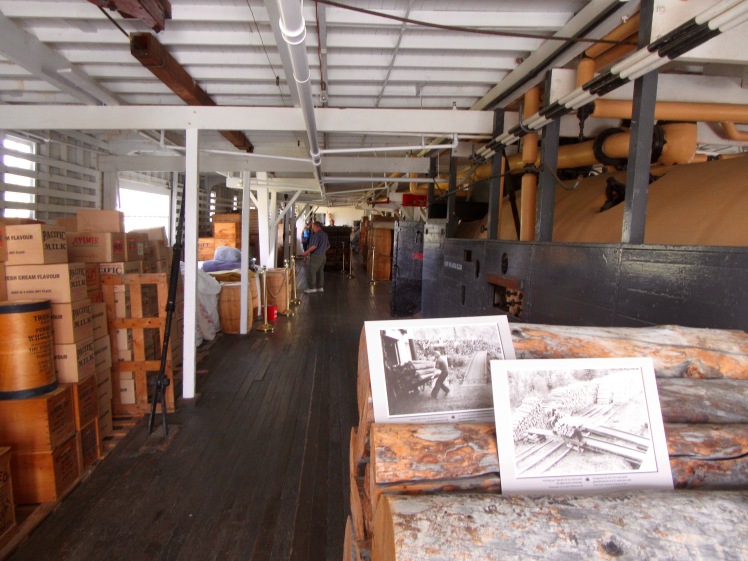
Whitehorse has a number of excellent museums. The McBride Museum of Yukon History is housed in a striking building: modern angles jutting out over a small wooden telegraph office.

Sam McGee’s original cabin. Robert Service’s poem “The Cremation of Sam McGee” was entirely fictitious, with the exception of the use of his name. Sam McGee was originally from Ontario, came to the Yukon to strike it rich in the Gold Rush, and when that failed, he stayed on to become a foreman and entrepreneur.

The art of Ted Harrison was also on display. Ted lived in the Yukon for a number of years and his paintings reflect the light he grew to love here.
Whitehorse was named for the Yukon rapids that were said to resemble the flowing manes of white horses. Harrison captured those white horses very effectively.
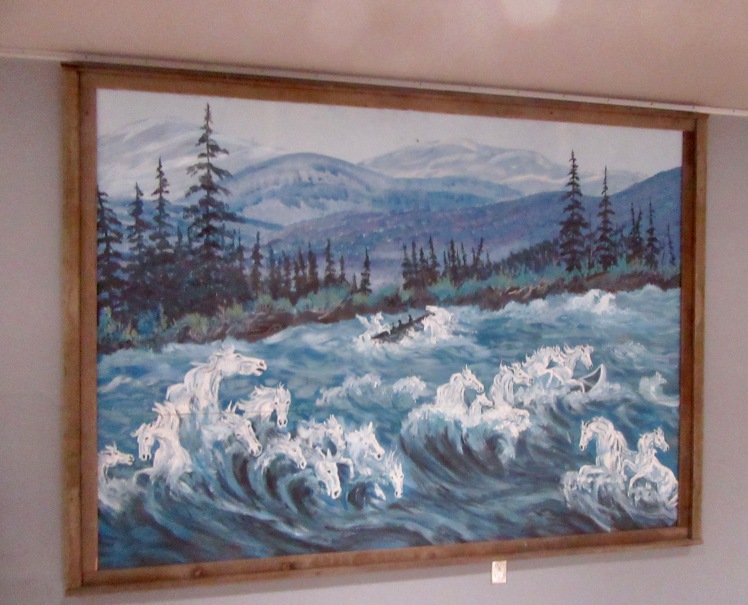
Although this was displayed in the same room, it has no credit, so I’m not sure if it is the work of Ted Harrison. What makes it noteworthy is that it is created entirely of coloured pushpins.
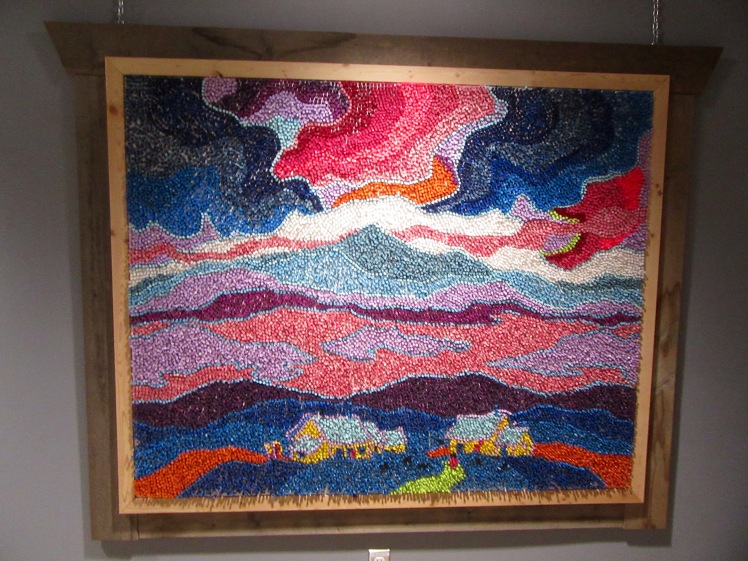
The Kwanlin Dun Cultural Centre showcases a variety of cultural activities, programs and art , celebrating the Kwanlin Dun First Nations.

As we travel through the Yukon and stop in at First Nations Heritage Centres, the emphasis is on the artwork, the beading, the dugout canoes.
By contrast, this is a gorgeous building that does nothing to sugar-coat the brutal history of the residential schools and displacement of the First Nations.

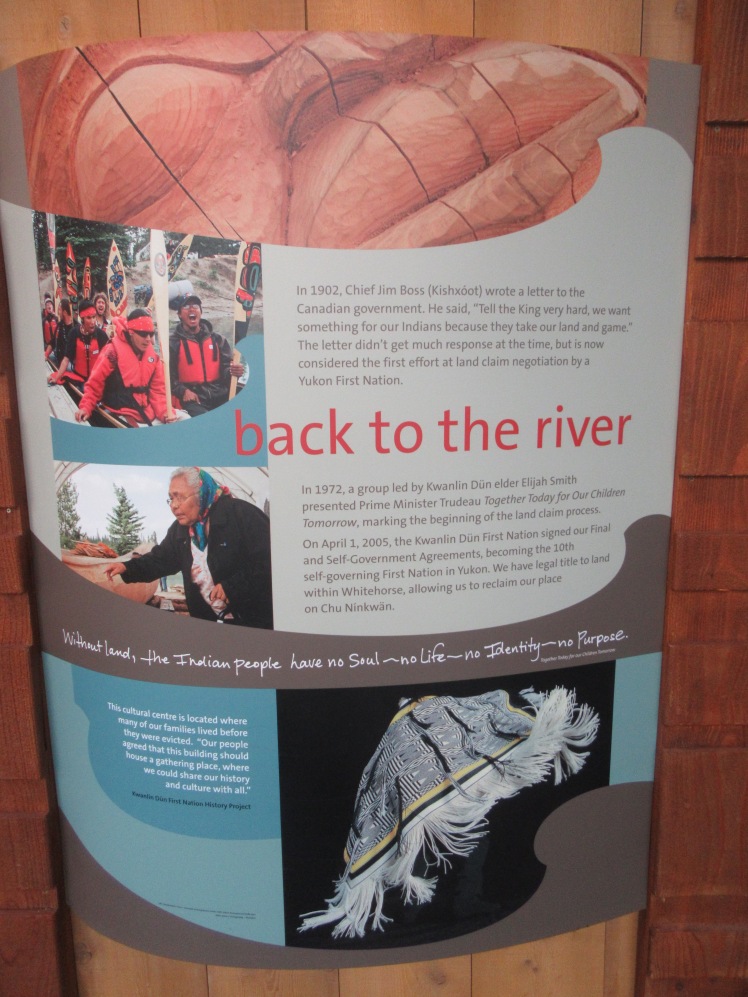
The Thursday Farmer’s Market is held on the riverfront – the usual happy affair of food, friends and families. It had rained the night before and we watched a few kids having great fun running through the puddles. This little girl was a bit tentative – it seems that she did not want to get her dress dirty.
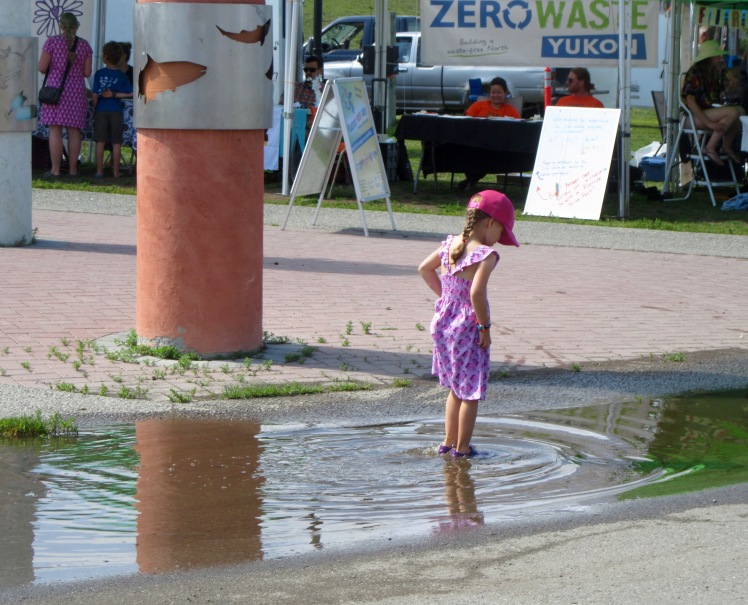
About five kilometres outside of Whitehorse is Miles Canyon, which is the namesake of the Kwanlin Dun First Nation who fished and hunted above the canyon. Before the river was dammed in the ’50s, it was extremely turbulent and provided a serious obstacle to the Gold Rush stampeders. It is now much calmer, although it still possesses a fierce current. A suspension bridge leads over to trails and views of the river.
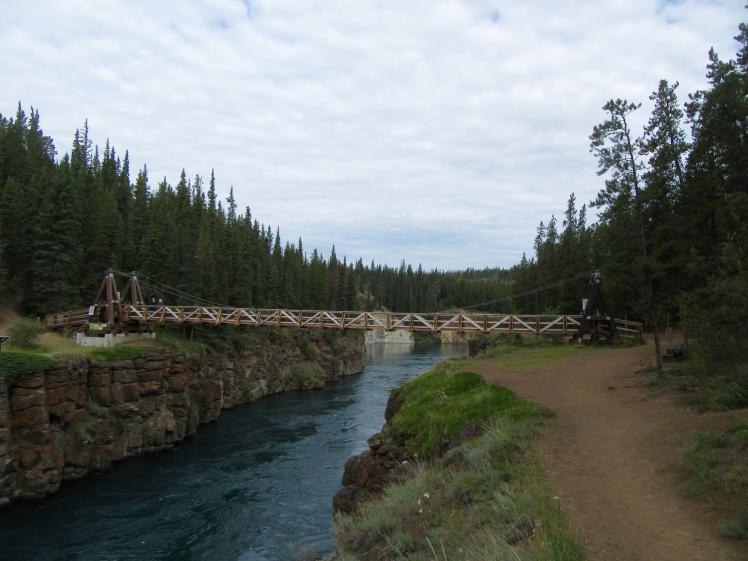

On the drive back into Whitehorse, we passed by a fleet of float planes. I was drawn to the bright red plane, as well as the colourful pots of flowers and bench.
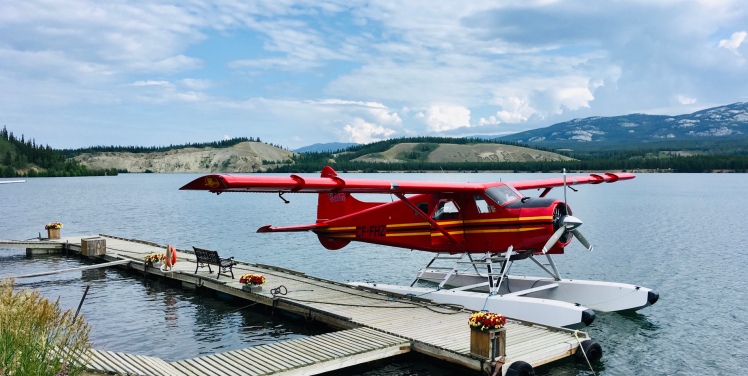
Next stop: Stewart Crossing, on our way to Dawson City.
Hi Ginny,
Same “log scraper” as we saw in ’77 and ’79. Also no Starbucks then ! How time changes everything. Much improved tourist attractions today. I so remember the S.S. Klondike and Miles Canyon. I am reliving my adventure through your wonderful blog. Keep them coming.
Lyn Morris
LikeLike
I think the travels in the ’70s were quite a bit more challenging, from what I hear. Although I’m sitting in the Visitor Centre right now (for wifi) and a fellow just popped in to say he had lost a tire.
We’re driving carefully – would be thrilled to make it though this trip without a flat. So far, so good – roads are just fine.
LikeLike
Hi Ginny and Steve,
Thank you for leading us on another adventure, vicarious though it may be (for us). I’ve never been further than Dease Lake on the way to Telegraph Creek, so this is a first to go further north. The scenery is grand and the characters you meet make it all the more compelling. I really had a chuckle about the “no snivelling” signs at Tetsa Lake Lodge. Is it about the gas prices, the bugs, something else, everything? Whatever, I’m sure some of us can be a real pain to local business people and up there they don’t have to take it. It’s not like the complainers can take their business elsewhere. You are inspiring us to go see for ourselves, but if that doesn’t happen, we’ll have thoroughly enjoyed this as the next best thing.
LikeLike
We have seen the “no snivelling” signs in a couple of places. I think it is a reminder that the locals aren’t thrilled about paying $1.80 for gas any more than the tourists are! It is more tongue-in-cheek than anything – you will not find more helpful and friendly people (except maybe for Newfoundland).
Well worth the drive, you two!
LikeLike
I have passed through Whitehorse many times on my trips to and from Alaska
but your posting has shown me many golden nuggets I missed in my travels.
Thanks for sharing your visit.
LikeLike
Thanks Pete! Another year we will make it up to your neck of the woods – so much to see there we don’t want to rush it.
LikeLike
Another magnificent experience. Brave should that you are. Enjoy. Certainly another perspective on guns here.
LikeLike
I think the big difference is that people up here don’t feel the need to pack a gun for protection against people.
LikeLike
Found your last two blogs interesting as we have just returned from an Inside Passage cruise to Alaska. Although we did not go as far as Skagway, we were in Juneau and Ketchikan and their main streets looked very similar to Skagway. Alas they did not benefit from our being there, as we were not in the market for diamonds!
LikeLike
Heather I’d love to hear about your cruise experience at some point – who knows we may find time to catch up about Leo!
We’d love to go to Alaska at some point – I think the scenery is a little different and more ruggedly beautiful than the Yukon.
LikeLike
HI Ginny and Steve, sorry to have missed you during your stay on Gabriola, hopefully next time you’re “home”. Just catching up with you, looks like quite the adventure you’re having. Reminds me of time I’ve spent in the Rockies seeing such beautiful lakes and rivers, and the wildlife. I’ve heard nothing but good things from people who have lived and played in Whitehorse, and the thriving arts scene there. Now I feel like I know the place a little better thanks to you. Great stories and pictures as ever. Thanks, happy trails to you!! …until we meet again 🙂
LikeLike
Garry, you and Donna could come up here as actors for the summer. Apparently they have actors, singers and dancers from all over Canada come for the summer and I think there is $$ in it! Imagine that!
Yes, so sorry we missed you, but we’re back south again in the fall, so we’ll make a point of getting together with you then.
Have a great summer!
LikeLike